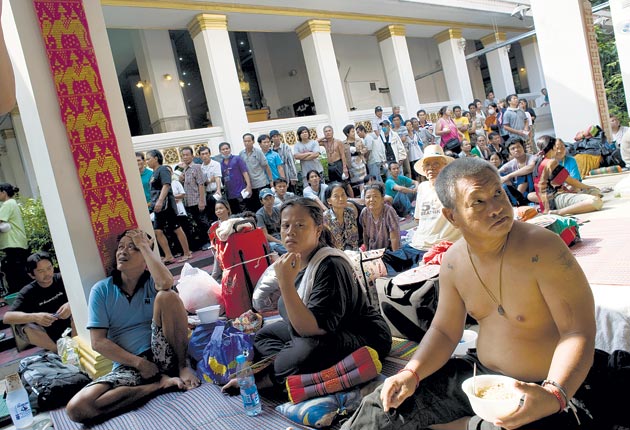Troops killed Red Shirts hiding in temple, official report admits
Leaked investigation contradicts Thai Prime Minister, who had blamed six gunshot deaths on protesters taking sanctuary

An official investigation into the deaths of protesters taking refuge in a Buddhist temple that had been declared a safe haven during Thailand's Red Shirt demonstrations in May this year has found that special forces were probably responsible.
This confirms eyewitness reports directly contradicting claims by the military that soldiers had not been present. Investigators said troops had taken position on an elevated railway track and fired high-velocity rounds into the Bangkok temple, where hundreds of terrified men, women and children were seeking sanctuary. The investigation also found that troops were most likely responsible for the death of a Japanese journalist this year.
Three of the six people who died in the temple were most likely killed by the soldiers' bullets. There was insufficient evidence to determine who was responsible for the other deaths, but investigators said all six who died in the temple compound were struck by high-velocity rounds. "There is a reasonable amount of facts, evidence and witness accounts to believe that [three] deaths resulted from security officials' actions on duty," said investigators. They recommended that police make further inquiries.
The findings by Thailand's Department of Special Investigation (DSI), revealed by the Reuters news agency, will put fresh pressure on the Thai Prime Minister Abhisit Vejjajiva, who had blamed the fatalities on opposition protesters. Mr Vejjajiva last night declined to comment until full investigatory and legal processes had been concluded. "The next step will involve the judicial process so we can't react to any incomplete information," he said.
The conclusion of the DSI inquiry will also both anger and embolden the anti-government Red Shirt movement, whose protests brought the centre of Bangkok to a halt and triggered the worst violence in the nation for three decades. More than 90 people died and 1,800 were injured. Yesterday, thousands of Red Shirts, also known as the United Front for Democracy against Dictatorship and many of them supporters of former prime minister Thaksin Shinawatra, held a peaceful protest in the capital.
The incident at Wat Pathum happened on 19 May after troops finally moved in to clear a nearby intersection which protesters had occupied for many weeks. The temple had been designated as a safe zone and protesters had been made aware of this. In the chaos following the clearing of the camp, and the subsequent setting alight of a shopping complex by a small number of Red Shirts, hundreds of frightened people poured into the grounds of the temple complex and set about finding somewhere to lay down for the night.
But in the late afternoon, shooting erupted in the road in front of the temple. Journalists who had been in the street said troops were firing at a small number of the protesters. Some witnesses said a tiny number of the Red Shirts were armed with guns, but most had just slingshots or fireworks. Most were not involved in any violence. One witness told the DSI team that he saw soldiers firing from the elevated train track into a makeshift medical tent close to the front of the 150-year-old temple. Two volunteer nurses, desperately trying to help the injured, were killed.
One of them was 25-year-old Kamolket Akahad, a Red Shirt supporter and volunteer subsequently named Nurse Kate, who was struck three times. Among those she rushed to help as bullets flew was The Independent's reporter, struck in the outer thigh by bullet fragments or shrapnel. The young woman's mother, Phayao, said that on the evening her daughter died, the pair had spoken on the phone, with gunfire and explosions sounding in the background. "I asked her where she was and she said she was at the front of the temple," she said. "I told her she needed to escape to the rear."
Soldiers questioned by the DSI team said they had fired warning shots towards the temple and came under fire from gunmen dressed in black, an apparent reference to the Red Shirt "security" personnel. They said they were providing cover fire for troops on the ground, who had requested backup.
The documents seen by Reuters suggest the DSI is looking into the deaths of 89 people. The government has yet to publicly release any findings despite pressure from human rights groups. A Truth and Reconciliation panel is also investigating the clashes and the causes of the violence.
The documents also suggest that Reuters' cameraman Hiro Muramoto, who died on 10 April while covering earlier clashes in the city's old quarter, was also killed by a high-velocity bullet in the chest. The report quoted a witness who said Mr Muramoto collapsed as gunfire flashed from the direction of soldiers. Thailand's government has not yet publicly released the report into his death despite repeated requests from the Japanese authorities. Another journalist, Italian photographer Fabio Polenghi, was killed on 19 May.
Tharit Pengdith, director general of the DSI, said investigators have concluded their preliminary work and passed the results to the police, but had not publicly disclosed the contents. "The investigation report is a sensitive issue to talk about or to confirm its authenticity," he said. "It's an official secret."
Subscribe to Independent Premium to bookmark this article
Want to bookmark your favourite articles and stories to read or reference later? Start your Independent Premium subscription today.

Join our commenting forum
Join thought-provoking conversations, follow other Independent readers and see their replies